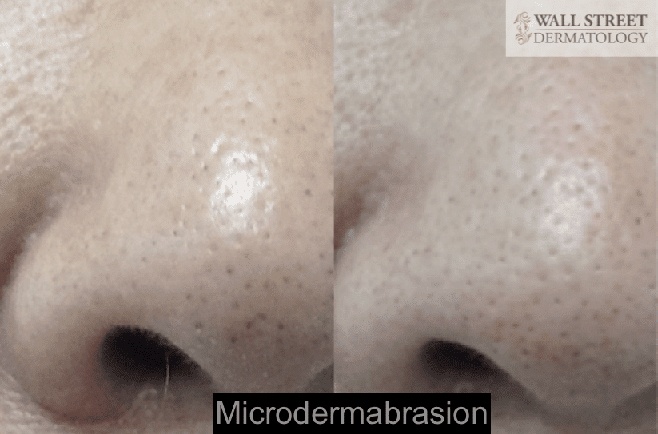Microdermabrasion: Your Pathway to Silky Smooth Skin
Precise, controlled exfoliation
- Last Updated: May 6, 2024
- By Julia Tzu, MD FAAD
Microdermabrasion in NYC
Microdermabrasion is a procedure for precise, controlled exfoliation of the superficial layer of the skin. This procedure can reveal younger-looking skin, improve discoloration, decrease pore size, and help prevent acne. You can see in our demonstration video below what the equipment and procedure looks like on your skin, along with a before-and-after following a microdermabrasion session.
Dermatologist Dr. Julia Tzu's Perspective on Microdermabrasion
How Does Microdermabrasion Work?
Microdermabrasion is a vacuum-based procedure that cleans out the pores and surface of the skin. Pores are decongested and the skin is exfoliated, revealing smooth, radiant skin with smaller pore sizes. Routine microdermabrasion has the benefit of maintaining healthy, glowing skin.
This photo below shows a microdermabrasion a before-and-after comparison of the skin after one microdermabrasion treatment.
How Often Can You Get Microdermabrasion?
The skin is a living, dynamic organ that is constantly turning over cells and producing secretions that accumulates within the pores. Microdermabrasion is a procedure that cleans the skin, and when combined with a vacuum, also decongests the pores. Hence, for optimum outcomes and to maintain continually radiant, clear, and decongested skin, microdermabrasion is recommended on a routine, monthly basis. One time treatments are sometimes opted by individuals to deep clean the skin before an important occasion.
How Much Does Microdermabrasion Cost in NYC?
The cost of microdermabrasion depends on the location and surface area of treatment. In general, average costs vary between $200 to 400 for each session.
Taking the Next Steps on Booking a Microdermabrasion Sessnion at Wall Street Dermatology
If you are interested in exploring microdermabrasion, you can learn more about booking a cosmetic consultation with Dr. Tzu. We’d love to explore how we may be able to restore the natural beauty of your skin.
FAQ
- When you arrive for your microdermabrasion appointment, you’ll check-in and be taken back to the procedure room. The process is relatively simple. An instrument with a diamond tip will be used to gently sweep your skin, removing the dead skin cells and revealing the fresh cells beneath. The instrument also vacuums the dead cells away from the face, leaving a clean, smooth appearance with no discomfort and minimal downtime. Pores will also be cleaned and decongested in the process, minimizing pore size. This is a New York City “lunchtime procedure”.
- In the week leading up to your appointment, it’s important to avoid certain other treatments, such as facial waxing, laser treatments, threading, electrolysis, chemical peels or other exfoliating beauty treatments.
- For five days before treatment, avoid injectable treatments like Botox and Juvederm
- For three days before treatment, steer clear of topical retinoid and anti-aging skin creams, acne treatments, bleaches and excessive sun exposure.
- The day of your appointment, avoid wearing makeup and be sure to arrive early enough to discuss any concerns with your dermatologist. Make it known if you suffer from facial or nasal herpes, also known as cold sores.
- Don’t use any unapproved topical products for 72 hours following your treatment. You can use products that are recommended by your dermatologist, but avoid anything you’re unsure about.
- After 72 hours, you can begin using a gentle moisturizer and facial wash, such as Avene Tolerance Extreme and Elta MD Foaming face wash.
- Don’t wear heavy makeup for the first few days.
- Avoid excessive sun exposure for the first week. If you need to spend time outside, be sure to wear a sunscreen that offers broad-spectrum protection with SPF 30 or higher.
One of the biggest benefits of this type of treatment is that there is no downtime. Commonly referred to as a “lunchtime procedure”, you can go back to work on the same day. Other than a slight dryness or mild irritation, you should not experience any discomfort.
Microdermabrasion is effective and safe for use on the face, chest, back, arms, legs, and hands, whereas chemical peels and other treatments are only recommended for the face. If the right type of microdermabrasion machine is used, it can also reduce pore size by declogging congested pores. It also offers much less discomfort and a much less downtime than many other procedures.
The microdermabrasion treatment can be customized to meet the needs of the patient. For example, an older patient with thinner, weaker skin can receive a treatment that’s gentler than a younger patient with skin that isn’t very sensitive. However, people with certain skin conditions/disorders should avoid the procedure, so ask your dermatologist whether this procedure is right for you. If you suffer from a condition that leaves open sores or blisters on your face or lips, have recently been sunburned, or have an active rash/inflammation, your skin is likely too sensitive for the procedure. Ask your dermatologist about options for treating your condition. If you’re able to clear up the problem, you might qualify for microdermabrasion later.
We recommend monthly microdermbrasion treatments for continued maintenance of decongested pores and vibrant, clear skin.
The treatment may lessen the appearance of mild scars over time. However, it is not recommended for treating deep or large scars
Yes, microdermabrasion can help the brown discoloration that result from acne, and can even help with preventing or reducing acne by deep cleansing the skin. It can also reduce the appearance of fine wrinkles, large pores, and blackheads.
You’ll notice an improvement in the look, feel, and texture of your skin right away. It might take serial treatments to noticeably reduce the appearance of discoloration.
We utilize the best of the medical-grade microdermabrasion system on the market. Our equipment is sterilized in a medical autoclave prior to every use, ensuring hygienic safety for all of our patients. Your procedure will also be performed by our dermatologist.


